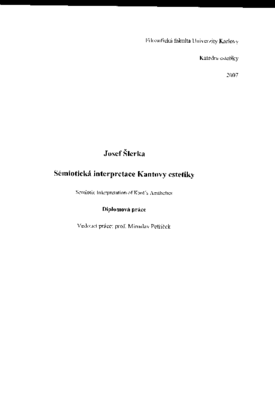Sémiotická interpretace Kantovy estetiky
Semiotic interpretation of Kant's aesthetics
diploma thesis (DEFENDED)

View/
Permanent link
http://hdl.handle.net/20.500.11956/10159Identifiers
Study Information System: 51584
Collections
- Kvalifikační práce [23975]
Author
Advisor
Referee
Ševčík, Miloš
Faculty / Institute
Faculty of Arts
Discipline
Aesthetics
Department
Department of Aestetics
Date of defense
28. 5. 2007
Publisher
Univerzita Karlova, Filozofická fakultaLanguage
Czech
Grade
Excellent
Práce Sémiotická interpretace Kantovy estetiky je věnována souvislostem mezi Peirceovou koncepcí sémiotiky a některými aspekty Kantovy filosofie a estetiky. První část práce nazvaná Peirce a jeho .filosofie se věnuje osvětlení základních pojmů a koncepcí Peirceovy filosofie. Druhá část nazvaná Kantova estetika ztotožňuje některé prvky Peirceova a Kantova přístupu. Díky tomu interpretuje některé základní koncepce Kantovy filosofie a estetiky jako teorie sémiotické, především se zaměřuje na vymezení krásy a vznešena pomocí Peirceova rozlišení ikonu a indexu. V dalším rozboru se text zaměřuje na aspekt subjektivace a tělesnosti v prožitku krásy a vznešena. Konečně pak třetí část nazvaná Roviny myšlení ukazuje, že takováto interpretace patří do širšího kontextu rovin lidského myšlení založeného na osách iracionality/racionality a absurdity/činné skepse.
The Semiotic lnterpretation of Kanťs Aesthetics deals with the relations between Peirce's serniotic concepts and some aspects of Kant' s philosophy and aesthetics. The first part, named Peirce And His Philosophy, presents basic terms and concepts of Peirce's philosophy. The second part, named Kanťs aesthetics, identifies some mutual elements of Peirce's and Kanťs approach. Therefore it interprets some basic concepts of Kanťs philosophy and aesthetics as semiotic, namely it tries to define the concept of beauty and sublimity by means of Peirce's distinction of icon and index. In the following analysis the text focuses on the aspect of subjectivation and sensuality in the experience of beauty and sublimity. Finally, the third part, named The Leve/s of Thought, shows that this interpretation belongs to a wider context of human thought levels based on the axes of the irrational/rational and absurdity/active skepticism.
